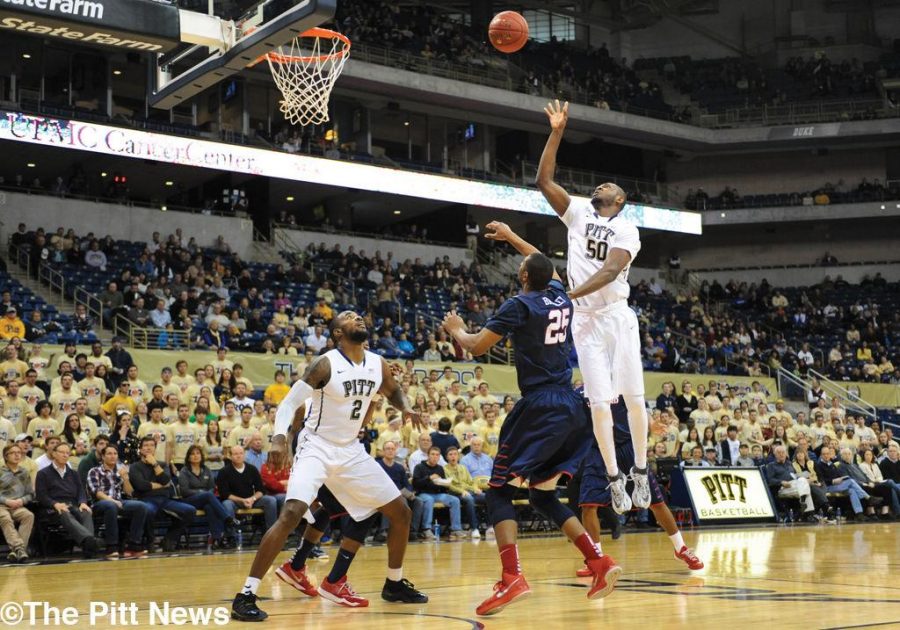Recovering Uchebo hopes to return to form
November 18, 2014
This is the second installment of a two- part story on Pitt basketball player Joe Uchebo. The first installment appeared in the Nov. 18 edition of The Pitt News.
Trust would also be paramount in Pitt center Joe Uchebo making an optimal recovery. He’d have to trust his right knee, something he wasn’t doing after testing it out in non-contact drills at Chipola College.
“He was visibly favoring that [left] leg and not confident, so it never got past that one day,” Uchebo’s junior college head coach Patrick Blake said.
From a broad standpoint, Pitt men’s basketball trainer Tim Beltz’s plans and goals for Uchebo were simple. If he could convince Uchebo to trust his right knee again, the brunt of Beltz’s work would be done.
“Making sure from a muscular standpoint that they have bilateral symmetry is always a paramount goal,” Beltz said. “Making sure from a health standpoint, they don’t favor one side versus another side, that’s always going to be part of the process.”
To get there, the pain in his right knee had to subside enough for him to stop favoring his left leg.
“It’s trying to find a pain free range of motion. With any surgical procedure, the objective from a performance standpoint is getting in a position where things aren’t painful,” Beltz said.
Uchebo arrived at Pitt in June 2013, and after evaluating him, Beltz and the rest of Pitt’s staff developed a rehabilitation plan to strengthen the surrounding structures of his knee and develop a pain free range of motion. Beltz used terminal knee extensions and isometrics, among other exercises, to do so.
From June to November, Uchebo went to rehab two or three times a day, starting at 6 a.m. The schedule was hectic, alternating between Beltz and Pitt’s athletic trainer Tony Salesi for rehab sessions and fitting in classes and tutoring in between.
“It was tough. Some people would quit, but I kept on pushing,” Uchebo said.
Following the initial six months, he stopped having to attend rehab as frequently each day. His knee was healthy enough for him to play sparse minutes for Pitt in the 2013-14 season, and his first appearance was against Maryland on Jan. 6, logging 23 minutes of playing time on the year (including postseason). But he was far from full health, still visibly favoring his right leg, which was hindering his running and jumping.
“It was tough, but I don’t have to show it. But now it’s really different, there’s less pain,” Uchebo said.
Despite the benefits of the rehab, Uchebo can’t play basketball like he did before the injury.
“If I’m on the right side on the post trying to muscle people, they try to block that place. To spin around, that knee, it doesn’t let me do all that stuff, it’s kind of tough. So I have to finish up on the same side where the defense is getting me. If my knee was OK, I would just spin, and it’s a dunk right there,” Uchebo said.
There’s also the mental aspect, because it’s hard for Uchebo to trust his pre-injury abilities when the knee still hurts.
“I have to watch how I jump. Sometimes when they pass me the ball, when I’m trying to go up and somebody’s coming, I have to be kind of scared due to my knee. But I’m still going to finish up,” Uchebo said. “Yeah, I’m still thinking about my knee because it still hurts. But that is not going to take anything out of me.”
Uchebo’s doctor said the pain is something he’ll have to deal with. He tries to focus away from his knee when he’s playing.
“The more I’m thinking about my knee, the more it’s taking my game away. I have to focus on the game, not trying to focus on the pain, so I won’t feel it that much,” he said.
Despite the pain and other limitations, Uchebo has made significant strides. Though not yet 100 percent, he’s getting closer to running without a hitch or favoring the knee. Also, he’s been able to make a substantial increase in the amount of pressure he can put on the knee, especially in weightlifting.
Uchebo trimmed down since arriving in Oakland, losing 40 to 50 pounds since he got to Pitt, with most of it coming off after last season. After the injury, he put on some unnecessary weight and had to lose it, especially to put less pressure on his knee.
“Ideally, you want to put the least amount of stress as you can on the body in a sport like basketball, where it’s an up and down game and it’s a game that involves a high level of fitness,” Beltz said. “So obviously, the leaner and lighter you can be, the more durable your body can be.”
Recent results have been encouraging. He dominated the Pittsburgh Basketball Club Pro-Am summer league, averaging 20.2 points and 20 rebounds per game in the regular season and was Pitt’s best center in its four-game summer tour in the Bahamas, averaging 7.5 points and 12.5 rebounds per game. Both performances helped earn him a spot in the Panthers’ starting five.
“It’s giving me hope. I keep pushing,” Uchebo said. “The Bahamas and summer league, it’s giving me an idea how the game is going to be, how it’s going to look like during the season.”
If Uchebo wants to return to his pre-injury form, Beltz said, he’ll need to continue to rehab daily, strengthening and pushing the surrounding structures of his knee,
Still, Uchebo is happy to be in his current position, feeling indebted to Pitt for having faith in his abilities. Now, Uchebo is ready to give back to the Pitt staff.
“They gave me a great chance, now it’s time for me to return the favor,” he said.



